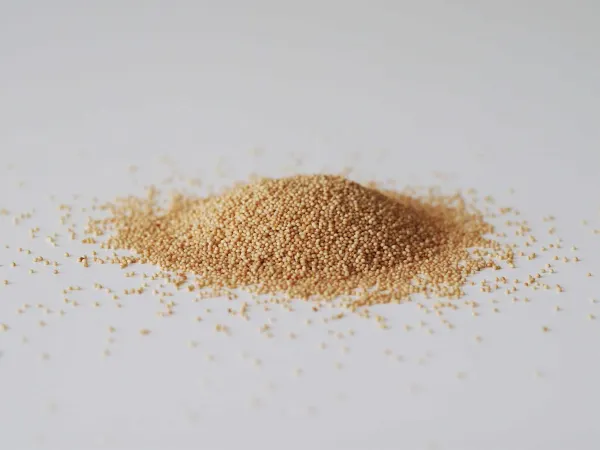Amaranth Seed
Pseudo Grain
Age Suggestion
6 months
Iron-Rich
Yes
Common Allergen
No

When can babies eat amaranth seed?
Amaranth may be introduced as soon as your baby is ready to start solids, which is generally around 6 months of age.
Background and origins of amaranth seed
Amaranth is a hardy plant that thrives in tropical climates around the world. Like quinoa, amaranth is often referred to as an ancient grain because of its storied history behind the plant’s edible seeds, which loom large in Aztec lore. The seeds were believed to hold spiritual power, and the Aztecs mixed them with blood to create cakes that were shaped like gods and eaten during ceremonial rituals. Recipe below—kidding!
Just like quinoa, amaranth is technically a pseudocereal, meaning the seeds boast a comparable nutritional profile and function like actual grains in cooking. In fact, the entire amaranth plant is edible—from root to stem to leaf to flower. There are more than 70 known varieties of amaranth in the world, with even more culinary uses. While the information here pertains to the seed, the leaves and stems are a popular leafy green in recipes around the world: Brazilian darurú, Greek vleeta, Indian chaulai saag, Indonesia bayam, Jamaican callalloo, Vietnamese rau dền, just to name a few!
Videos
Is amaranth healthy for babies?
Yes! Amaranth seed is a protein powerhouse that’s packed with vitamin B6, folate, iron, magnesium, selenium, and zinc. One cup of cooked amaranth seed contains 9+ grams of protein and 5 milligrams of iron—that’s almost an entire day’s requirement of protein and half the daily needs of iron for a 6- to 12-month-old baby.
For gluten-free eaters, amaranth is a fantastic alternative to rice, which pales in comparison from a standpoint of nutrition. Try serving cooked amaranth seed in place of rice in a salad, a porridge, a soup, or on its own as a side dish with meat or fish.
Is amaranth a common choking hazard for babies?
No, amaranth is not a common choking hazard, though in theory, an individual can choke on any food. Always stay near your baby and check out our age-appropriate serving suggestions.
For more information, visit our section on gagging and choking and familiarize yourself with common choking hazards.
Is amaranth a common allergen?
No. Amaranth allergy is rare. In fact, amaranth is often used as a replacement for allergenic foods, such as soy and wheat.
As you would do when introducing any new food, start by serving a small quantity of cooked amaranth seed on its own for the first couple of times. If there is no adverse reaction, gradually increase the quantity over future servings.
How do you prepare amaranth for babies with baby-led weaning?
Every baby develops on their own timeline, and the suggestions on how to cut or prepare particular foods are generalizations for a broad audience.
6 to 12 months old:
Serve amaranth as a warm cereal. To encourage self-feeding, pre-load your baby’s spoon and hand it to your baby in the air or rest it on the edge of a bowl that suctions to the table for your baby to pick up independently.
12 to 18 months old:
This is a great age to encourage utensils. Try working with 2 or 3 spoons (pre-loading as you go).
18 to 24 months old:
Use amaranth liberally in your cooking. It knows no bounds! Explore recipes for grain dishes, patties, porridges, and yogurt parfaits. At this age it’s best to avoid recipes with added sugar or sweeteners. Instead, cook amaranth in naturally sweet liquids like unsweetened almond and coconut milks and mix in fruits to sweeten your baby’s cereal. This will help your baby develop a taste for sweets from foods that are not artificially sweet, which is important at this age when eating preferences are taking root.
Lightly toast dried amaranth seeds on the stovetop until they pop, then sprinkle on top of yogurt. The little seeds will add fascinating crunch and texture for little ones!
Amaranth seed makes a great base for casseroles, cereals, grain salads, and soups. It can also be toasted and sprinkled on top of foods for a lovely crunch. Be sure to start by rinsing amaranth seed to remove any dirt and debris, and if you have the time, soak the seeds for 4 to 8 hours. Time in the water helps make the seeds more digestible and increases nutrient absorption.
For more information on how to cut food for babies, visit our page on Food Sizes & Shapes.
Written by
Expert Tips Delivered to Your Inbox
Sign up for weekly tips, recipes and more!
The content offered on SolidStarts.com is for informational purposes only. Solidstarts is not engaged in rendering professional advice, whether medical or otherwise, to individual users or their children or families. No content on this site, regardless of date, should ever be used as a substitute for direct medical advice from your doctor or your medical or health professional, nutritionist, or expert in pediatric feeding and eating. By accessing the content on SolidStarts.com, you acknowledge and agree that you are accepting the responsibility for your child’s health and well-being. In return for providing you with an array of content “baby-led weaning” information, you waive any claims that you or your child may have as a result of utilizing the content on SolidStarts.com.




